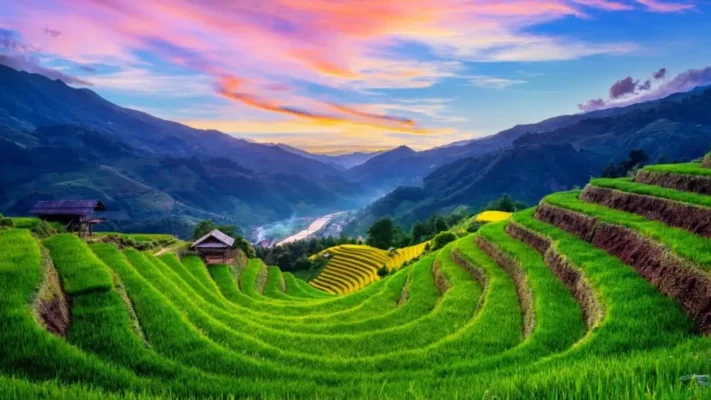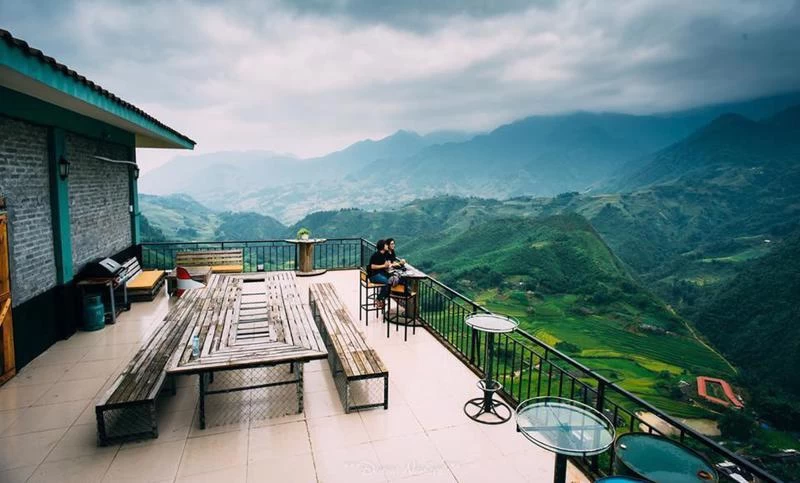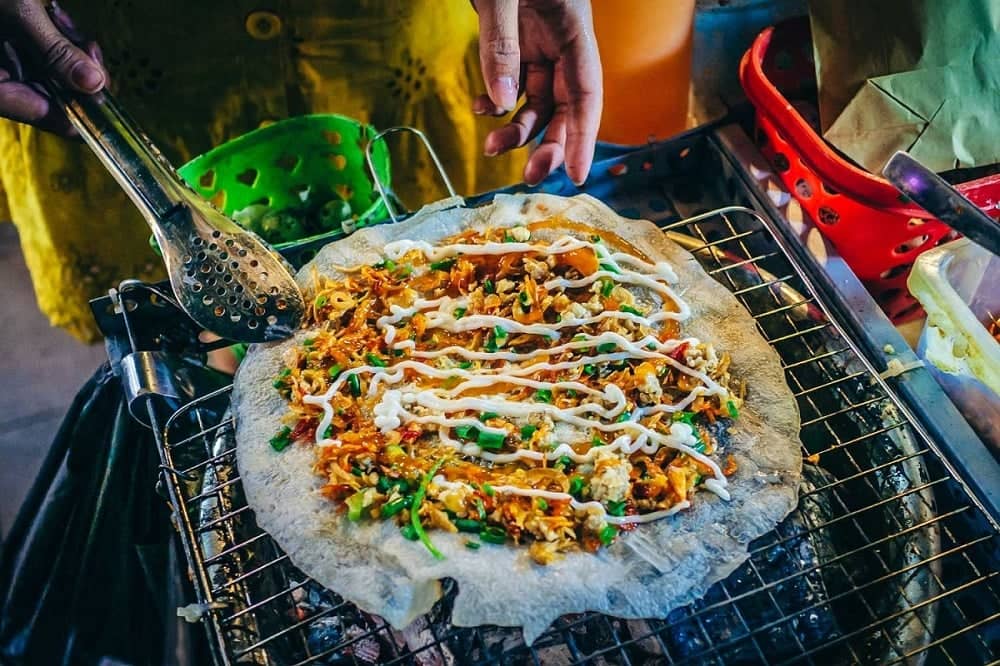
Follow Ula Travel to explore Sapa!
Explore the best things to do in Sapa, from hiking the majestic Fansipan Peak and wandering the picturesque Muong Hoa Valley to immersing yourself in local culture at traditional ethnic villages and bustling markets. Enjoy adventure activities, savor local cuisine, and find out the best time to visit this beautiful destination. Get insider tips on accommodation and travel essentials for an unforgettable experience in Sapa.
I. Introduction to Sapa
1. Overview of Sapa

Sapa is a destination not to be missed when exploring northern Vietnam.
Sapa is a picturesque mountain town located in the northern highlands of Vietnam, near the border with China. Nestled at an altitude of approximately 1,500 meters (4,920 feet) above sea level, Sapa is renowned for its breathtaking natural landscapes and rich cultural diversity. The town is situated in the Lao Cai Province and offers stunning views of terraced rice fields, lush valleys, and majestic peaks, including the renowned Mount Fansipan, the highest mountain in Indochina.
2. Why Visit Sapa?
- Stunning Natural Beauty: Sapa is celebrated for its awe-inspiring scenery, including rolling hills, deep valleys, and verdant terraced rice fields that change color with the seasons. The view of the Hoang Lien Son mountain range, with Mount Fansipan towering above, offers a dramatic and unforgettable experience.
- Cool and Refreshing Climate: Unlike the hot and humid conditions found in much of Vietnam, Sapa boasts a temperate climate with cool temperatures throughout the year. This makes it an ideal destination for those looking to escape the heat and enjoy outdoor activities in a more comfortable environment.
- Rich Cultural Experience: Sapa is home to a diverse array of ethnic minority groups, each with its own unique customs, traditions, and handicrafts. Visitors have the opportunity to immerse themselves in the local culture by visiting traditional villages such as Cat Cat, Ta Van, and Lao Chai. Here, you can interact with the indigenous people, observe their daily lives, and learn about their traditional crafts and festivals.
- Charming Local Markets: Sapa’s markets are vibrant hubs where local communities gather to sell fresh produce, handicrafts, and traditional goods. The Sapa Market and various ethnic minority markets are excellent places to experience the local way of life and purchase unique souvenirs.
Learn more about: Hanoi to Sapa tours
II. Explore Sapa with Natural Landscapes
1. Fansipan: The Roof of Indochina

Fansipan- The Roof of Indochina
Fansipan is the highest peak in the Indochina Peninsula, towering at 3,147 meters (10,326 feet) above sea level. Located in the Hoang Lien Son mountain range in northern Vietnam, this majestic peak is often shrouded in clouds, offering breathtaking views and a serene escape from the bustling city life. Fansipan is a prominent feature of the Hoang Lien National Park, which is renowned for its diverse flora and fauna, including rare and endangered species.
Start your journey with: Hanoi to Sapa Private Tour
2. The Terraced Rice Fields

The terraced rice fields in sapa
The terraced rice fields of Sapa are not just agricultural marvels but also stunning visual spectacles. Carved out over centuries by the local ethnic minority groups, including the H’mong and Dao people, these fields showcase the harmonious relationship between human ingenuity and nature. In the early morning or late afternoon light, the fields glisten with dew or reflect the golden hues of the setting sun, creating a picturesque landscape that is a photographer’s dream.
3. Muong Hoa Valley

Muong Hoa Valley
Muong Hoa Valley is one of Sapa’s most enchanting natural wonders, renowned for its breathtaking landscapes and cultural richness. The valley is a remarkable showcase of the region’s natural splendor, featuring expansive rice terraces that change colors with the seasons.
During the planting season, the fields are a vibrant green, while in the harvest season, they turn a golden yellow. The surrounding hills, often shrouded in mist, create a picturesque backdrop that is perfect for photography and exploration.
Do not miss: Sapa Tour from Hanoi 7 Days
4. Silver Waterfall and Love Waterfall

Silver Waterfall
Silver Waterfall (Thac Bac): Silver Falls, locally known as Thac Bac, is one of the most spectacular waterfalls in Sapa. This impressive waterfall cascades down from a height of approximately 200 meters, creating a breathtaking display of natural splendor. The falls are named “Silver” due to the shimmering, silvery appearance of the water as it glides over the rocks and plunges into the pool below.

Love Waterfall
Love Waterfall (Thac Tinh Yeu): Love Falls, or Thac Tinh Yeu, is another gem in Sapa’s treasure trove of natural attractions. This enchanting waterfall is nestled in a lush forest, cascading down a series of rocky steps. The falls are named “Love” due to the romantic and serene atmosphere that surrounds the site, making it a popular spot for couples and those seeking a peaceful retreat.
III. Discovering Local Culture in Sapa
1. Visiting Ethnic Villages
a. Cat Cat Village

Cat Cat Village
Cat Cat Village is a charming ethnic village located about 3 kilometers from Sapa town. It is primarily inhabited by the H’mong people, one of the prominent ethnic groups in the region. Visiting Cat Cat Village offers a unique opportunity to immerse yourself in the traditional H’mong culture.
Cultural Insights:
- H’mong Culture: The H’mong people are known for their vibrant traditional clothing, rich cultural heritage, and intricate embroidery. During your visit, you’ll witness traditional customs and practices that have been preserved for generations.
- Traditional Houses: The village features traditional H’mong houses made of wood and bamboo. These structures are typically built on stilts, providing a glimpse into the traditional architectural style of the H’mong community.
Click here: Northern Vietnam Wonders
b. Ta Van Village

Ta Van Village
Ta Van Village is located about 8 kilometers from Sapa and is renowned for its diverse ethnic communities, including the Dao Do (Red Dao) and the H’mong people. The village offers a fascinating insight into the cultural richness of these ethnic groups.
Cultural Insights:
- Dao Do Culture: The Red Dao people are known for their distinctive red clothing, elaborate silver jewelry, and traditional herbal medicine. Visiting Ta Van provides an opportunity to learn about their unique customs, such as traditional rituals and festivals.
- H’mong Influence: While exploring Ta Van, you’ll also encounter elements of H’mong culture, as the village is home to both ethnic groups. This blend of cultures enriches the overall experience, offering a deeper understanding of the region’s diversity.
You will be like: Explore 5 Main Ethnic Minorities in Sapa
2. Sapa’s Traditional Market

Bac Ha market
Sapa’s traditional market, also known as the Sapa Market, is a vibrant hub of local culture and commerce. Held weekly, this market is a must-visit for those wanting to experience the authentic atmosphere of this mountainous region. Located in the heart of Sapa town, it is surrounded by the picturesque landscapes of northern Vietnam, making it a perfect spot to delve into the local way of life. The most prominent market in Sapa is the Bac Ha market (held every Sunday); however, there are numerous other marketplaces to explore.
Shopping for Souvenirs:
- Handcrafted Items: The market is renowned for its wide array of handcrafted goods. You can find beautifully woven textiles, traditional clothing, intricate jewelry, and vibrant accessories made by the local ethnic minorities, such as the H’mong, Dao, and Tay people. These items reflect the rich cultural heritage and artistic skills of the artisans.
- Local Crafts: Look out for unique handmade crafts like embroidered bags, colorful scarves, and decorative wooden items. These souvenirs make great gifts and keepsakes from your visit.
Cultural Experience:
- Interactions with Locals: The market is a lively place where you can interact with local vendors and ethnic minority groups. Engaging in conversations and learning about their daily lives and traditions can provide deeper insights into Sapa’s cultural tapestry.
- Festive Atmosphere: The market’s atmosphere is festive and bustling, with traditional music and dances occasionally performed. It’s a great opportunity to immerse yourself in the local cultural festivities and enjoy the vibrant scene.
Read more: Hanoi to Bac Ha Market Tour
IV. Best Things to Do in Sapa
1. Mountain Climbing and Trekking in Sapa
a. Conquer Fansipan Mountain

Fansipan mountain trekking
Fansipan, standing at 3,143 meters (10,312 feet) above sea level, is the highest peak in the Indochina Peninsula. Often referred to as the “Roof of Indochina,” climbing Fansipan is a bucket-list adventure for many. The mountain’s diverse ecosystems range from temperate forests at lower elevations to alpine meadows and rocky ridges near the summit.
Trekking Details:
- Duration: The trek to Fansipan can take between 2 and 4 days, depending on the chosen route and your fitness level.
- Routes: The most popular routes include the Tram Ton Pass route, the Sin Chai route, and the Cat Cat route. Each route offers unique landscapes and varying levels of difficulty.
- Experience: Trekkers will navigate through dense forests, cross rivers, and ascend steep slopes, culminating in breathtaking panoramic views from the summit. The experience is physically demanding but highly rewarding.
You might be like: Northern Vietnam Itinerary
b. Hoang Lien Son Mountain Range

Hoang Lien Son Mountain Trekking
The Hoang Lien Son Mountain Range, where Fansipan is located, extends over 180 kilometers and features several other peaks and trails worth exploring. This range is known for its diverse flora and fauna, including rare species of plants and animals.
Trekking Details:
- Popular Trails: Trails such as the Ta Phin, Lao Chai, and Muong Hoa offer varying levels of difficulty and different experiences. The trails wind through lush terraced rice fields, traditional ethnic villages, and scenic valleys.
- Duration: Treks can vary from a single day to several days, depending on the route and your preference.
c. Muong Hoa Valley Trekking

Muong Hoa Valley Trekking
The Muong Hoa Valley is renowned for its beautiful terraced rice fields, ethnic minority villages, and picturesque views. Trekking through this valley provides a glimpse into the traditional lifestyle of the local H’mong and Dao people.
Trekking Details:
- Duration: A typical trek through Muong Hoa Valley can last from a few hours to a full day.
- Experience: This trek is less strenuous than climbing Fansipan and is ideal for those who want to experience Sapa’s natural beauty at a more relaxed pace. Highlights include visits to local villages, exploration of ancient stone carvings, and views of expansive rice terraces.
d. The Ethnic Village Treks

Tourists visit ethnic minority villages in Sapa.
Sapa’s surrounding ethnic villages, including Cat Cat, Ta Van, and Ban Ho, offer unique trekking experiences. These treks provide insights into the daily lives and traditions of various ethnic groups.
Trekking Details:
- Duration: These treks usually range from a few hours to a full day, depending on the distance and the number of villages visited.
- Experience: Trekkers will walk through charming villages, visit local markets, and enjoy traditional meals with the locals.
2. Discover Sapa by Motorbike Tour

Discover Sapa by Motorbike Tour
A motorbike tour in Sapa offers an exhilarating way to experience the breathtaking landscapes and vibrant culture of this picturesque region. Known for its rugged terrain and scenic beauty, Sapa is an ideal destination for adventurous travelers seeking a unique and immersive exploration. Here’s a detailed overview of what to expect from a Sapa motorbike tour:
- Experience the Scenic Beauty: Riding a motorbike through Sapa allows you to fully immerse yourself in the stunning natural surroundings. From rolling hills and terraced rice paddies to dramatic mountain vistas and lush valleys, the tour provides panoramic views that are often missed when traveling by car or bus.
- Explore Off-the-Beaten-Path Locations: Unlike traditional tours, a motorbike adventure enables you to access remote and less-visited areas. This includes hidden villages, tranquil lakes, and pristine nature spots that offer a more intimate experience of Sapa’s beauty.
- Cultural Encounters: As you navigate through the various villages, you’ll have the opportunity to meet local ethnic minority groups, such as the Hmong, Dao, and Tay people. These interactions provide a deeper understanding of their traditional lifestyles, crafts, and customs.
V. Must-Try Local Delicacies
- Com Lam (Bamboo Sticky Rice): Com Lam, or bamboo sticky rice, is a traditional dish of the ethnic minorities in Sapa. This unique delicacy is made by cooking sticky rice inside a bamboo tube, giving it a distinct aroma and flavor.
- Thang Co: Thang Co is a traditional dish of the H’mong people, known for its rich and savory flavor. It is a type of stew made with beef or horse meat, various herbs, and spices.
- Salmon Hot Pot (Lau Ca Hoi): Salmon hot pot, or Lau Ca Hoi, is a popular dish in Sapa, taking advantage of the region’s fresh, local salmon. This hot pot is known for its flavorful broth and fresh ingredients.
- Meo Apple Wine (Rượu Táo Mèo): Meo Apple Wine, or Rượu Táo Mèo, is a traditional alcoholic beverage made from the local Meo apples, which are grown in the mountainous regions of Sapa. This wine is known for its distinct apple flavor and smooth finish.
You will be like: Sapa cuisine
VI. Travel Tips and Experiences
1. Best Time to Visit Sapa
- Spring (March to May): This is an ideal time to visit Sapa. The weather is mild, with temperatures ranging from 15°C to 22°C (59°F to 72°F). Spring brings blooming flowers and lush greenery, making it perfect for trekking and exploring the picturesque landscapes.
- Autumn (September to November): Autumn is another excellent period to visit Sapa. The weather is cooler and drier, with temperatures between 14°C and 21°C (57°F to 70°F). The rice terraces turn golden, providing breathtaking views and ideal conditions for photography.
Do not miss: Sapa Wearther
2. Sapa Accommodation

Topas Ecolodge is one of the most beautiful resorts in Sapa
Sapa offers a range of hotel options, from budget to luxury. Some popular choices include:
- Topas Ecolodge: A luxury eco-resort offering stunning views and a serene environment.
- Sapa Eden Hotel: A comfortable mid-range hotel with convenient access to Sapa’s attractions.
- Hmong Sapa Hotel: A budget-friendly option with basic amenities and a central location.
For a more immersive experience, consider staying with local families. Homestays offer insight into the daily lives and cultures of the ethnic minorities in Sapa. Some notable homestays include:
- Lao Chai Homestay: Located in a picturesque village with traditional wooden houses and home-cooked meals.
- Ta Van Homestay: Situated in the Ta Van village, this homestay provides a genuine cultural experience with local hospitality.
Learn more about: Sapa Hotels
3. Hanoi to Sapa
- Train: The most scenic and comfortable option is to take a train from Hanoi to Lao Cai, followed by a 1-hour bus ride to Sapa. The train journey offers beautiful views of the countryside.
- Bus: Several bus companies operate between Hanoi and Sapa. There are both standard and sleeper buses available, with the journey taking approximately 6-7 hours.
- Private Car: For convenience and flexibility, hiring a private car or taxi is a good option. The journey takes around 5–6 hours and allows for stops along the way.
In summary, Sapa is a captivating destination that seamlessly blends stunning natural landscapes with rich cultural experiences. From hiking the majestic Fansipan and exploring the picturesque Muong Hoa Valley to engaging with the local ethnic communities and savoring unique regional cuisine, Sapa offers a diverse array of activities for every traveler. Its enchanting scenery and welcoming atmosphere ensure that every visit is both memorable and fulfilling. Whether you’re seeking adventure or tranquility, Sapa promises an unforgettable journey into the heart of northern Vietnam.
See more: Sapa travel tips




























